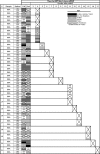Detection of HIV-1 drug resistance in women following administration of a single dose of nevirapine: comparison of plasma RNA to cellular DNA by consensus sequencing and by oligonucleotide ligation assay
- PMID: 20181911
- PMCID: PMC2863880
- DOI: 10.1128/JCM.02062-09
Detection of HIV-1 drug resistance in women following administration of a single dose of nevirapine: comparison of plasma RNA to cellular DNA by consensus sequencing and by oligonucleotide ligation assay
Abstract
A single dose of nevirapine (sdNVP) to prevent mother-to-child transmission of HIV-1 increases the risk of failure of subsequent NVP-containing antiretroviral therapy (ART), especially when initiated within 6 months of sdNVP administration, emphasizing the importance of understanding the decay of nevirapine-resistant mutants. Nevirapine-resistant HIV-1 genotypes (with the mutations K103N, Y181C, and/or G190A) from 21 women were evaluated 10 days and 6 weeks after sdNVP administration and at the initiation of ART. Resistance was assayed by consensus sequencing and by a more sensitive assay (oligonucleotide ligation assay [OLA]) using plasma-derived HIV-1 RNA and cell-associated HIV-1 DNA. OLA detected nevirapine resistance in more specimens than consensus sequencing did (63% versus 33%, P<0.01). When resistance was detected only by OLA (n=45), the median mutant concentration was 18%, compared to 61% when detected by both sequencing and OLA (n=51) (P<0.0001). The proportion of women whose nevirapine resistance was detected by OLA 10 days after sdNVP administration was higher when we tested their HIV-1 RNA (95%) than when we tested their HIV-1 DNA (88%), whereas at 6 weeks after sdNVP therapy, the proportion was greater with DNA (85%) than with RNA (67%) and remained higher with DNA (33%) than with RNA (11%) at the initiation of antiretroviral treatment (median, 45 weeks after sdNVP therapy). Fourteen women started NVP-ART more than 6 months after sdNVP therapy; resistance was detected by OLA in 14% of the women but only in their DNA. HIV-1 resistance to NVP following sdNVP therapy persists longer in cellular DNA than in plasma RNA, as determined by a sensitive assay using sufficient copies of virus, suggesting that DNA may be superior to RNA for detecting resistance at the initiation of ART.
Figures




Similar articles
-
Association between detection of HIV-1 DNA resistance mutations by a sensitive assay at initiation of antiretroviral therapy and virologic failure.Clin Infect Dis. 2010 May 15;50(10):1397-404. doi: 10.1086/652148. Clin Infect Dis. 2010. PMID: 20377404 Free PMC article.
-
Efficacy and safety of 1-month postpartum zidovudine-didanosine to prevent HIV-resistance mutations after intrapartum single-dose nevirapine.Clin Infect Dis. 2010 Mar 15;50(6):898-908. doi: 10.1086/650745. Clin Infect Dis. 2010. PMID: 20158398 Free PMC article.
-
Lower risk of resistance after short-course HAART compared with zidovudine/single-dose nevirapine used for prevention of HIV-1 mother-to-child transmission.J Acquir Immune Defic Syndr. 2009 Aug 15;51(5):522-9. doi: 10.1097/QAI.0b013e3181aa8a22. J Acquir Immune Defic Syndr. 2009. PMID: 19502990 Free PMC article. Clinical Trial.
-
Minority HIV-1 drug-resistant mutations and prevention of mother-to-child transmission: perspectives for resource-limited countries.AIDS Rev. 2014 Oct-Dec;16(4):187-98. AIDS Rev. 2014. PMID: 25300623 Review.
-
Use of single-dose nevirapine for the prevention of mother-to-child transmission of HIV-1: does development of resistance matter?Am J Obstet Gynecol. 2007 Sep;197(3 Suppl):S56-63. doi: 10.1016/j.ajog.2007.02.031. Am J Obstet Gynecol. 2007. PMID: 17825651 Review.
Cited by
-
A comparison of 3 regimens to prevent nevirapine resistance mutations in HIV-infected pregnant women receiving a single intrapartum dose of nevirapine.Clin Infect Dis. 2012 Jan 15;54(2):285-93. doi: 10.1093/cid/cir798. Epub 2011 Dec 5. Clin Infect Dis. 2012. PMID: 22144539 Free PMC article. Clinical Trial.
-
Evaluation of the management of pretreatment HIV drug resistance by oligonucleotide ligation assay: a randomised controlled trial.Lancet HIV. 2020 Feb;7(2):e104-e112. doi: 10.1016/S2352-3018(19)30337-6. Epub 2019 Dec 7. Lancet HIV. 2020. PMID: 31818716 Free PMC article. Clinical Trial.
-
Transmitted HIV resistance to first-line antiretroviral therapy in Lima, Peru.AIDS Res Hum Retroviruses. 2012 Apr;28(4):333-8. doi: 10.1089/aid.2011.0131. Epub 2011 Aug 5. AIDS Res Hum Retroviruses. 2012. PMID: 21819256 Free PMC article.
-
Clinical implications of HIV-1 minority variants.Clin Infect Dis. 2013 Jun;56(11):1667-74. doi: 10.1093/cid/cit125. Epub 2013 Feb 27. Clin Infect Dis. 2013. PMID: 23446628 Free PMC article.
-
Oligonucleotide ligation assay detects HIV drug resistance associated with virologic failure among antiretroviral-naive adults in Kenya.J Acquir Immune Defic Syndr. 2014 Nov 1;67(3):246-53. doi: 10.1097/QAI.0000000000000312. J Acquir Immune Defic Syndr. 2014. PMID: 25140907 Free PMC article.
References
-
- Arvold, N. D., N. Ngo-Giang-Huong, K. McIntosh, V. Suraseranivong, B. Warachit, S. Piyaworawong, T. Changchit, M. Lallemant, and G. Jourdain. 2007. Maternal HIV-1 DNA load and mother-to-child transmission. AIDS Patient Care STDS 21:638-643. - PubMed
-
- Balzarini, J., A. Karlsson, M.-J. Pérez-Pérez, M. J. Camarasa, W. G. Tarpley, and E. De Clercq. 1993. Treatment of human immunodeficiency virus type 1 (HIV-1)-infected cells with combinations of HIV-1-specific inhibitors results in a different resistance pattern than does treatment with single-drug therapy. J. Virol. 67:5353-5359. - PMC - PubMed
-
- Beck, I. A., C. Crowell, R. Kittoe, H. Bredell, M. Machaba, C. Willamson, W. Janssens, S. Jallow, G. van der Groen, Y. Shao, M. Jacob, N. M. Samuel, I. L. de Rivera, N. Ngo-Giang-Huong, S. Cassol, G. Alemnji, and L. M. Frenkel. 2008. Optimization of the oligonucleotide ligation assay, a rapid and inexpensive test for detection of HIV-1 drug resistance mutations, for non-North American variants. J. Acquir. Immune Defic. Syndr. 48:418-427. - PMC - PubMed
-
- Bi, X., H. Gatanaga, S. Ida, K. Tsuchiya, S. Matsuoka-Aizawa, S. Kimura, and S. Oka. 2003. Emergence of protease inhibitor resistance-associated mutations in plasma HIV-1 precedes that in proviruses of peripheral blood mononuclear cells by more than a year. J. Acquir. Immune Defic. Syndr. 34:1-6. - PubMed
-
- Coovadia, A., G. Hunt, E. J. Abrams, G. Sherman, T. Meyers, G. Barry, E. Malan, B. Marais, R. Stehlau, J. Ledwaba, S. M. Hammer, L. Morris, and L. Kuhn. 2009. Persistent minority K103N mutations among women exposed to single-dose nevirapine and virologic response to nonnucleoside reverse-transcriptase inhibitor-based therapy. Clin. Infect. Dis. 48:462-472. - PMC - PubMed
Publication types
MeSH terms
Substances
Grants and funding
LinkOut - more resources
Full Text Sources
Other Literature Sources
Medical

